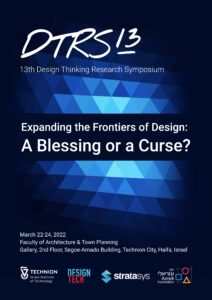Expanding the frontiers of design: a blessing or a curse?
In the last decade or two, we have seen an unprecedented widening of the boundaries of what is considered as ‘design’. In the 20th century established design disciplines became regulated and to practice them academic credentials have become a must. Educational programs of design disciplines have, by and large, moved to universities, where they are, alone or in combination, regular departments, schools or faculties. For the most part design disciplines are considered professions, which implies specific modes of education and training, different from those in both science and humanities education. Naturally, in addition to pure ‘professionalism’, the design has also attracted considerable discourse as a field, with its own history, theory, and philosophy, in parallel to, and beyond, professional matters.
In the 21st century, the concept of design has experienced considerable turbulence as its boundaries have been extended to include new notions and activities that transcend traditional definitions, agendas and practices of design. One of the indicators of this development is the surfacing of the term Design Thinking in its particular meaning as a methodology, recommended for anyone who is engaged in innovation processes, including business and management agents, as well as laypeople. The Design Thinking Research Symposia (DTRS) series, which started in 1992 in Delft, has employed the term ‘design thinking’ in its simple and straight-forward sense, that is, a description and analysis of how designers think. This was part of a wider reaction to the ‘design methods movement’ that had earlier aspired to develop methods for effective design processes, to the point of automating them. We can use the evolution of DTRS meetings to follow the changes in the conceptualization of design, especially if we look at some of the meetings that had used shared data. DTRS2 in 1994 was the almost mythological protocol analysis-focused meeting; it used a dataset recording industrial designers at work – an individual and a team of three designers. DTRS7 in London (2007) used two sets of data, generated in architectural design meetings and mechanical engineering design sessions. DTRS10 at Purdue University (2014) had a wide scope of datasets taken from educational settings – ‘crits’ – in a variety of disciplines, including industrial design, mechanical engineering, choreography, entrepreneurship and more. DTRS11 in Copenhagen in 2016, featured a data set which dealt with strategies for market penetration into a non-European culture by a large European corporation. In 2018, at DTRS12 held at UNIST in Ulsan, the data package was a mixture of information from designers in a range of industrial outfits, a design educator, and management and marketing experts.
We see that the essential matter that was offered as design data has widened from core disciplines like mechanical engineering, industrial design and architecture towards new horizons, including a variety of disciplines that two decades ago probably would not have been considered ‘design’, like choreography (representing an array of additional disciplines), and further on, prominently, also managerial activity in business. To deal with the wide range of design-related activity a terminology has been suggested that distinguished between “specialist” design/ers and “generalist” design/ers.
This state of affairs requests reflection. From the point of view of design, designers, and design researchers are the new breadth of the scope of design a blessing? Is “everything is design”, a statement voiced quite frequently, a positive development in the field of design? Or is it, as some argue, a detrimental condition, which voids the concept of design from the solid contents it used to hold? Needless to say, there may be quite a few positions in between these two extremities of the continuum from blessing to curse in the widening of the meaning of design. The questions raised by this dilemma are numerous, and they pertain to the design process, the knowledge base of design, the role of technology in design, the educational and pedagogical base for training designers, and, most importantly, the designer or designers – who are they now and who will they be in the future? Who is a “specialist” designer and who a “generalist” designer”?
In DTRS13 at the Technion, we hope to explore these and related questions. THERE WILL BE NO SHARED DATA FOR DTRS13, BUT IN THE TRADITION OF DTRS, WE ASK THAT SUBMITTED CONTRIBUTIONS BE EVIDENCE-BASED. That is, they can be protocol-based, case studies, and so on. Comparisons are always welcome. However, if any interested parties own data (in English) that they deem relevant to the conference theme and which they are willing to share, they are welcome to send this data to us and we will disseminate it through the conference website.
We invite contributions of timely evidence-based examinations of the current roles and limits, or lack thereof, of what can be named design (as opposed to/in conjunction with related practices?), who can be called designers, how this differs from the past and what can be predicted for the future.
* The conference is to take place on Tuesday to Thursday, March 22-24, 2022 (postponed from spring 2021 owing to the Covid-19 pandemic). On Friday, March 25, we plan a post-conference tour, pending on enough interested participants. Options for the tour: a) Jerusalem and environs. b) Galilee (including Nazareth) and environs. There will be an extra charge for the tour.
The conference will convene at the Technion campus in Haifa
Gabriela Goldschmidt and Ezri Tarazi
dtrs13@technion.ac.il
